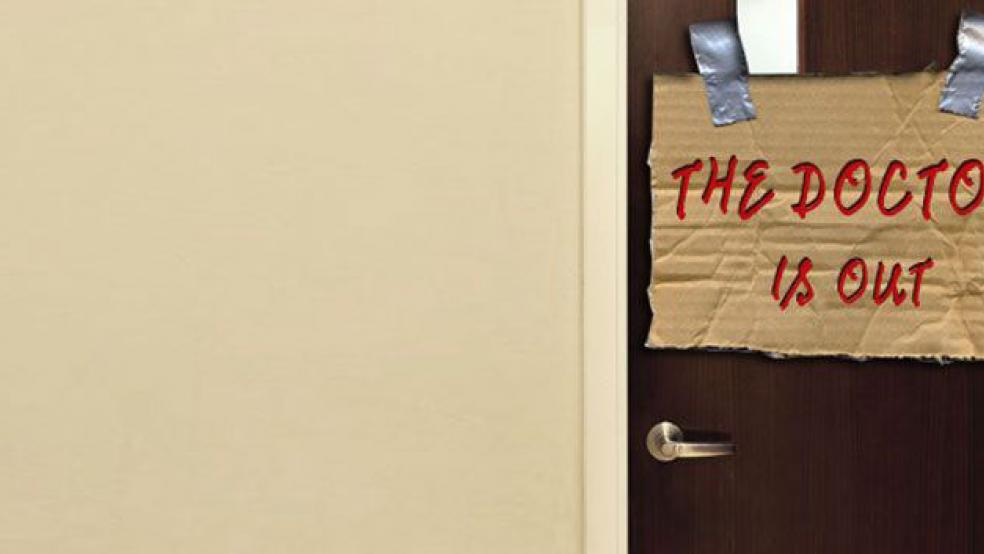The headline seemed like the newspaper equivalent of one of those obnoxious hospital monitors suddenly going from a periodic beep to a buzzer. "More Doctors Steer Clear of Medicare," The Wall Street Journal blared recently.
The story detailed how the number of doctors opting out of Medicare has “nearly tripled” last year compared with three years ago and described the mounting frustrations – low reimbursement rates, bureaucratic incentives – behind that apparent trend.
"Family physicians have been fed up for a long time and it's getting worse," Jeffrey Cain, president of the American Academy of Family Physicians, was quoted as saying.
So are doctors really abandoning their elderly patients? While many are certainly not taking Medicare patients anymore, the big picture is much more nuanced.
First, a little math helps clarify what’s really been happening. There are about 685,000 physicians in the U.S. who accept Medicare patients. Last year, according to the Centers for Medicare and Medicaid Services (CMS), some 9,539 doctors chose to opt out of Medicare. That's up from 3,700 in 2009, but it’s still less than 2 percent, which is hardly a mass exodus.
The Journal piece may have broadly captured the frustration of doctors, but didn't present the whole picture. According to Dan Diamond, writing in CaliforniaHealthline:
“What the Journal didn't report is that, per CMS, the number of physicians who agreed to accept Medicare patients continues to grow year-over-year, from 705,568 in 2012 to 735,041 in 2013. And other providers aren't turning down Medicare, either. The number of nurse practitioners participating in the program has only gone up, Jan Towers of the American Academy of Nurse Practitioners told California Healthline.”
More importantly, there is no mass movement among physicians to leave Medicare patients in the cold. A report released last month by the Department of Health and Human Services found that:
- According to federal survey data, the percentage of all office-based physicians who report accepting new Medicare patients has not changed significantly between 2005 and 2012, with 87.9 percent of physicians accepting new Medicare patients in 2005 and 90.7 percent in 2012.
- The percentage of physicians who report accepting new Medicare patients is similar to, and in recent years slightly higher than, the percentage accepting new privately insured patients.
- Medicare beneficiary access to care is high and has remained stable over the past five years.
Another unsubstantiated claim is that doctors are bailing from Medicare due to the introduction of the Affordable Care Act, or Obamacare, next year.That, too, doesn't hold up to scrutiny. Here's Dr. Don McCanne, writing for the Physicians for a National Health Program blog (PNHP supports a single-payer system):
“Those who say that Obamacare is forcing more doctors to drop out of Medicare will have to explain to us how that computes with the fact that the numbers of physicians agreeing to accept Medicare has increased by almost 30,000 this year alone, for an all-time high of over 735,000.”
As Diamond notes, many doctors feel "ethically obligated" to stick with Medicare, because, after all, they would be refusing to accept some of their most vulnerable patients who can't easily find another general practitioner who knows their medical history.
DOCTORS STILL UNHAPPY WITH MEDICARE
That's not to say that the 99 percent of doctors still treating Medicare patients are sanguine over reimbursement rates. The major medical lobbies have been fighting a 1997 law that would cut fees even more next year –by 25 percent – unless Congress acts again to delay the cuts, as it has done repeatedly since the law first passed.
Like patients, doctors have gotten hit with higher costs. In addition to inflationary increases, they have to hire people just to process insurance forms. It's not known if their burden will be lighter under the new health exchanges that the Affordable Care Act mandates in every state come October.
"While Medicare physician payment rates have remained flat since 2001, practice costs have increased by more than 20 percent due to inflation, leaving physicians with a huge gap between what Medicare pays and what it costs to care for seniors," AMA President Dr. Ardis Hoven told Forbes.
There have been various proposals to scale back or scrap the “sustainable growth rate” (SGR) formula, but Congress hasn't gone near it recently. Doctors continue to fight against it. Meanwhile, federal deficit hawks have been more active in trying to craft a workable solution, as eliminating the SGR might keep reimbursement rates from being slashed but it would also cost the U.S. Treasury some $138 billion.
The latest idea for a "permanent" SGR fix is contained in a bill approved by the House Energy and Commerce Committee before Congress broke for its summer recess. It had rare bi-partisan support and may be joined by companion measures from the House Ways and Means and Senate Finance Committees.
The basic plan scraps the SGR formula and replaces it with annual raises for doctors of 0.5 percent. A system of evaluating "quality performance" will be put in place. Those performing well will receive additional bonuses in compensation. A group of providers would devise the rating scales.
Keep in mind that the SGR fix is part of a larger thorny dilemma. Do doctors get a break while Medicare imposes compensation cuts on hospitals and other providers? That's unlikely, and legislators are scrambling to address reimbursement issues across the board. Such a compromise may be part of a larger debt-ceiling package to be introduced this fall.
Fixing the SGR won’t end all doctors’ complaints about Medicare, but it could be a useful step toward the ultimate goal in the debate over health care: a way to fairly compensate providers while still reining in costs and ensuring quality care that focuses on the health of the patients.






